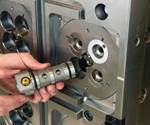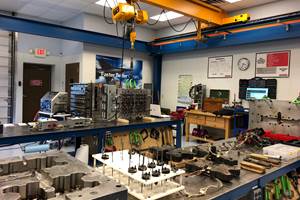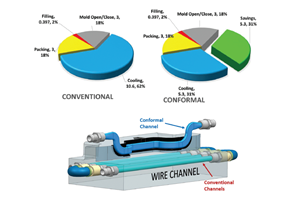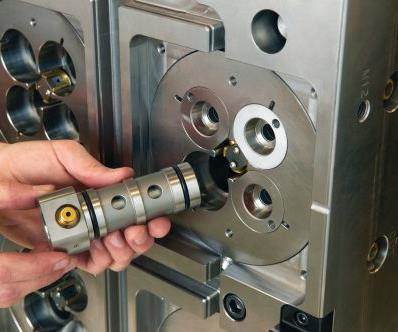In the Trenches: An Ounce of Prevention - Design Review
Examining a troubled tool from a design review perspective can reveal engineering options.
In light of the last two installments of this article series, it seems only fitting to address the question that has been lurking in the background: “What should have been done differently?” This is not meant to imply second-guessing, finger-pointing or blame, only to demonstrate that lessons can be learned from failed attempts. The old adage “Nothing ventured, nothing gained” holds true.
It is our nature to assume everything we do will be correct, otherwise why would we do it? We seldom stop to review what went right, but the pain and cost of failure gives us pause to reflect. We often learn more from our mistakes than we do from our successes.
For the last eight years, I have worked for a corporation that has a well-defined and constantly evolving design review process, evidenced by more than 600 new mold launches in those eight years—most with great success.
Molds are becoming larger and more complex, and the fact that a problem one (such as the one we’ve been examining in the last two articles) slipped through is not terribly surprising nor is it cause for undue concern. Rather its rarity stands as a testament to the effectiveness of design review. It also serves to keep our focus on continuous improvement, which pushes us to refine our design review process so that a particular “gotcha” does not get us a second time.
From my perspective (remember, we’re in the trenches), the design review process serves two purposes: 1) to verify that the mold meets capability requirements and restrictions, and 2) to make a maintainable mold.
Keep in mind that design review is a process, not a step. It takes place in several stages, moving from big-picture requirements to final-finish details. Nothing is off limits for discussion. For example, if a specific detail about the electrical connection pops into someone’s mind during preliminary design, it should be noted on an actions list and revisited when necessary.
Mold design is influenced by part design, and part design is influenced by everything from styling and materials engineering to manufacturability. And occasionally, mold design is even influenced by those charged with mold maintenance.
Meeting Capability Requirements and Restrictions
After basic assumptions are made and preliminary design is complete, it’s time for a review of the part/mold/press interface. This helps determine if the mold will make the part and if it will fit the press. Here are a few factors to consider:
Clamp tonnage. Keep in mind that just because a mold fits in a press does not mean the press has enough tonnage to keep the mold clamped under injection pressure. Remember to estimate the required clamp tonnage and double-check it if someone else has done the estimation.
Robotics. Verify that the robot can extract the part from the press. The mold and the press may be correct, but you need to consider what will happen if the part is longer than the space between the tie bars. Imagine what will happen if the tie bars strip the part off the EOA as it exits the press. Not all robots are able to articulate to overcome such obstacles, so you need to have full details about the capabilities of the robots you are using.
Press layout. Graphic layouts for each press in the plant should be included in a design review notebook (see illustration). They are an excellent quick reference for project meetings. Include tie bar spacing, minimum and maximum shut height, maximum opening, number of valve gates and actions, etc.
Disruptions. The design review process is an evolving one, so details such as locating ring size and barrel size to evaluate residence time against cycle time should be added continually to improve the process. In short, anything that has caused disruption in your operation should be noted and referred to with each new mold to help keep the same mistakes from happening twice.
Additional insight. Design engineers and repair technicians cannot cover all the bases in this process, so be sure to consult process engineers, industrial engineers, and secondary and assembly operations technicians. They each can offer valuable input to ensure a successful mold or product launch.
Making a Maintainable Mold
After the mold fits the press and is making good parts, it’s time to focus on life-cycle maintenance. We have all experienced maintenance migraines involving molds that in the end taught us how to do our jobs better. The mold discussed in the last two articles is one such case whose lessons I’ve applied to similar mold projects. Those lessons relate to:
Injection pressure. I now consider the possible effects of lateral forces caused by injection pressure. The mold’s large bathtub lock had a replaceable wear plate on the outboard side, but the injection pressure’s lateral force was on the inboard surface, causing wear and galling that resulted in debris and contamination. In hindsight, even a guy without an engineering degree should have figured out that the wear plate belongs on the inboard surface.
Alignment. This mold also taught me lessons about alignment hardware, which is now listed on my design review checklist as “more (bigger) is better; two-piece locks are generally better (more robust) than a three-piece setup.”
Part orientation. How you orient the part is also essential. We flipped this mold 180 degrees to eliminate the “shelf” where debris could settle. Lesson learned: Evaluate how best
to orient a part to avoid issues such as this in the future.
Family molds. Family molds teach lessons too, especially when their parts vary in size. Using gate and runner sizing to balance fill is only minimally effective. It’s best not to mold a grille and a door handle in the same mold, for example. Instead push for separate molds when family parts are significantly different.
Clothespin-type slide retainers. These may cause failures also. So much so that I now look for them in preliminary designs and specify an alternate detent when possible. Maintenance issues with galled components have forced me to look twice at ejector pins, hole finishes, straight lifters, die lock angles and bypass shut-off surfaces.
Tapers. Tapers of 1 to 3 degrees may work for draft angles but are self-locking when it comes to tooling. We specify angles of a minimum of 7 degrees for lifter heads and 10 degrees for die locks. Even with those minimums and thermal expansion, we still have to occasionally contend with galled die locks.
Make a List and Check It Twice
These are just a few of the more notable and painful challenges I have faced, and lessons I have learned. Your list may vary, but the key to avoiding these challenges is to establish a solid design review. So, keep notes, make checklists and explore different options. A proper design review will better your game, decrease your headaches, streamline your operations and improve your bottom line.
Related Content
Precision Meets Innovation at IMTS 2024
After attending IMTS, it's clear that the integration of advanced technologies is ready to enhance precision, efficiency and automation in mold manufacturing processes. It’s a massive event, so here’s a glimpse of what the MMT team experienced firsthand.
Read MoreWhat You Need to Know About Hot Runner Systems and How to Optimize Their Performance
How to make the most out of the hot runner design, function and performance.
Read MoreHow to Use Thermal Management to Improve Mold Cooling
A review of common mold cooling issues and possible solutions, including 3D printing applications.
Read More5 Hot Runner Tips for Moldmakers and Molders
Best practices for initial hot runner tryouts and effective preventive maintenance.
Read MoreRead Next
In the Trenches: Mold Repair
In this multi-part series of articles, contributer James Bourne, a tool repair supervisor and freelance writer, shares his own personal struggles in the business, as well as lessons learned and tricks of the trade garnered along the way.
Read MoreReasons to Use Fiber Lasers for Mold Cleaning
Fiber lasers offer a simplicity, speed, control and portability, minimizing mold cleaning risks.
Read MoreAre You a Moldmaker Considering 3D Printing? Consider the 3D Printing Workshop at NPE2024
Presentations will cover 3D printing for mold tooling, material innovation, product development, bridge production and full-scale, high-volume additive manufacturing.
Read More




















